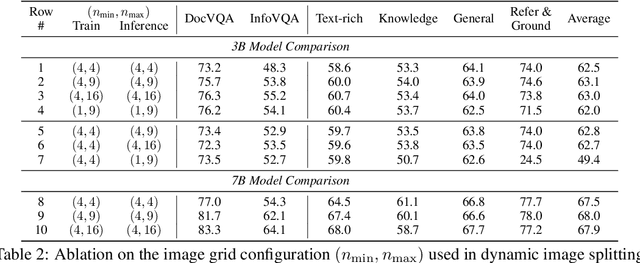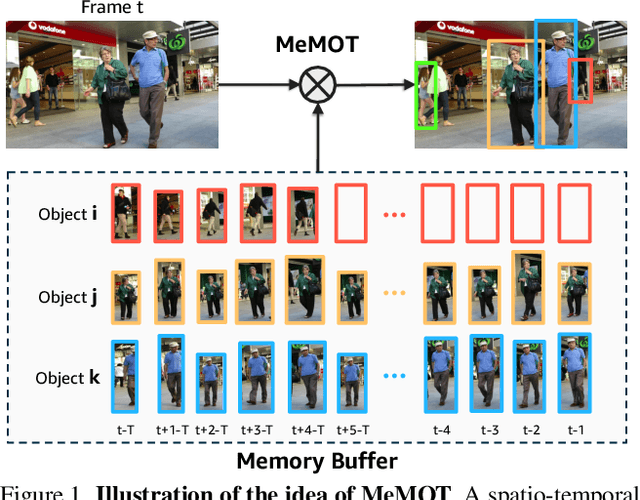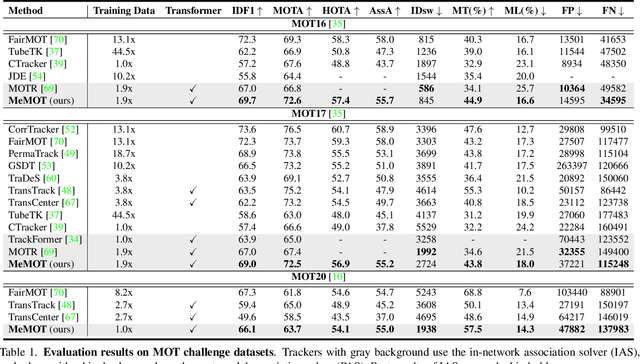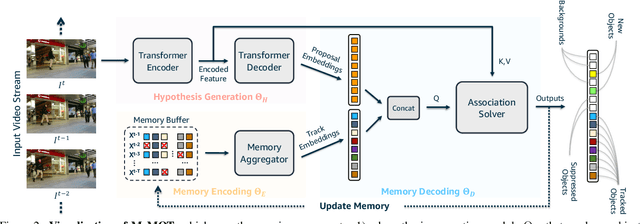Mingze Xu
AToken: A Unified Tokenizer for Vision
Sep 19, 2025Abstract:We present AToken, the first unified visual tokenizer that achieves both high-fidelity reconstruction and semantic understanding across images, videos, and 3D assets. Unlike existing tokenizers that specialize in either reconstruction or understanding for single modalities, AToken encodes these diverse visual inputs into a shared 4D latent space, unifying both tasks and modalities in a single framework. Specifically, we introduce a pure transformer architecture with 4D rotary position embeddings to process visual inputs of arbitrary resolutions and temporal durations. To ensure stable training, we introduce an adversarial-free training objective that combines perceptual and Gram matrix losses, achieving state-of-the-art reconstruction quality. By employing a progressive training curriculum, AToken gradually expands from single images, videos, and 3D, and supports both continuous and discrete latent tokens. AToken achieves 0.21 rFID with 82.2% ImageNet accuracy for images, 3.01 rFVD with 40.2% MSRVTT retrieval for videos, and 28.28 PSNR with 90.9% classification accuracy for 3D.. In downstream applications, AToken enables both visual generation tasks (e.g., image generation with continuous and discrete tokens, text-to-video generation, image-to-3D synthesis) and understanding tasks (e.g., multimodal LLMs), achieving competitive performance across all benchmarks. These results shed light on the next-generation multimodal AI systems built upon unified visual tokenization.
UniGen: Enhanced Training & Test-Time Strategies for Unified Multimodal Understanding and Generation
May 20, 2025Abstract:We introduce UniGen, a unified multimodal large language model (MLLM) capable of image understanding and generation. We study the full training pipeline of UniGen from a data-centric perspective, including multi-stage pre-training, supervised fine-tuning, and direct preference optimization. More importantly, we propose a new Chain-of-Thought Verification (CoT-V) strategy for test-time scaling, which significantly boosts UniGen's image generation quality using a simple Best-of-N test-time strategy. Specifically, CoT-V enables UniGen to act as both image generator and verifier at test time, assessing the semantic alignment between a text prompt and its generated image in a step-by-step CoT manner. Trained entirely on open-source datasets across all stages, UniGen achieves state-of-the-art performance on a range of image understanding and generation benchmarks, with a final score of 0.78 on GenEval and 85.19 on DPG-Bench. Through extensive ablation studies, our work provides actionable insights and addresses key challenges in the full life cycle of building unified MLLMs, contributing meaningful directions to the future research.
StreamBridge: Turning Your Offline Video Large Language Model into a Proactive Streaming Assistant
May 08, 2025Abstract:We present StreamBridge, a simple yet effective framework that seamlessly transforms offline Video-LLMs into streaming-capable models. It addresses two fundamental challenges in adapting existing models into online scenarios: (1) limited capability for multi-turn real-time understanding, and (2) lack of proactive response mechanisms. Specifically, StreamBridge incorporates (1) a memory buffer combined with a round-decayed compression strategy, supporting long-context multi-turn interactions, and (2) a decoupled, lightweight activation model that can be effortlessly integrated into existing Video-LLMs, enabling continuous proactive responses. To further support StreamBridge, we construct Stream-IT, a large-scale dataset tailored for streaming video understanding, featuring interleaved video-text sequences and diverse instruction formats. Extensive experiments show that StreamBridge significantly improves the streaming understanding capabilities of offline Video-LLMs across various tasks, outperforming even proprietary models such as GPT-4o and Gemini 1.5 Pro. Simultaneously, it achieves competitive or superior performance on standard video understanding benchmarks.
SlowFast-LLaVA-1.5: A Family of Token-Efficient Video Large Language Models for Long-Form Video Understanding
Mar 27, 2025Abstract:We introduce SlowFast-LLaVA-1.5 (abbreviated as SF-LLaVA-1.5), a family of video large language models (LLMs) offering a token-efficient solution for long-form video understanding. We incorporate the two-stream SlowFast mechanism into a streamlined training pipeline, and perform joint video-image training on a carefully curated data mixture of only publicly available datasets. Our primary focus is on highly efficient model scales (1B and 3B), demonstrating that even relatively small Video LLMs can achieve state-of-the-art performance on video understanding, meeting the demand for mobile-friendly models. Experimental results demonstrate that SF-LLaVA-1.5 achieves superior performance on a wide range of video and image tasks, with robust results at all model sizes (ranging from 1B to 7B). Notably, SF-LLaVA-1.5 achieves state-of-the-art results in long-form video understanding (e.g., LongVideoBench and MLVU) and excels at small scales across various video benchmarks.
MM1.5: Methods, Analysis & Insights from Multimodal LLM Fine-tuning
Sep 30, 2024



Abstract:We present MM1.5, a new family of multimodal large language models (MLLMs) designed to enhance capabilities in text-rich image understanding, visual referring and grounding, and multi-image reasoning. Building upon the MM1 architecture, MM1.5 adopts a data-centric approach to model training, systematically exploring the impact of diverse data mixtures across the entire model training lifecycle. This includes high-quality OCR data and synthetic captions for continual pre-training, as well as an optimized visual instruction-tuning data mixture for supervised fine-tuning. Our models range from 1B to 30B parameters, encompassing both dense and mixture-of-experts (MoE) variants, and demonstrate that careful data curation and training strategies can yield strong performance even at small scales (1B and 3B). Additionally, we introduce two specialized variants: MM1.5-Video, designed for video understanding, and MM1.5-UI, tailored for mobile UI understanding. Through extensive empirical studies and ablations, we provide detailed insights into the training processes and decisions that inform our final designs, offering valuable guidance for future research in MLLM development.
From Text to Insight: Leveraging Large Language Models for Performance Evaluation in Management
Aug 09, 2024Abstract:This study explores the potential of Large Language Models (LLMs), specifically GPT-4, to enhance objectivity in organizational task performance evaluations. Through comparative analyses across two studies, including various task performance outputs, we demonstrate that LLMs can serve as a reliable and even superior alternative to human raters in evaluating knowledge-based performance outputs, which are a key contribution of knowledge workers. Our results suggest that GPT ratings are comparable to human ratings but exhibit higher consistency and reliability. Additionally, combined multiple GPT ratings on the same performance output show strong correlations with aggregated human performance ratings, akin to the consensus principle observed in performance evaluation literature. However, we also find that LLMs are prone to contextual biases, such as the halo effect, mirroring human evaluative biases. Our research suggests that while LLMs are capable of extracting meaningful constructs from text-based data, their scope is currently limited to specific forms of performance evaluation. By highlighting both the potential and limitations of LLMs, our study contributes to the discourse on AI role in management studies and sets a foundation for future research to refine AI theoretical and practical applications in management.
SlowFast-LLaVA: A Strong Training-Free Baseline for Video Large Language Models
Jul 22, 2024



Abstract:We propose SlowFast-LLaVA (or SF-LLaVA for short), a training-free video large language model (LLM) that can jointly capture the detailed spatial semantics and long-range temporal context without exceeding the token budget of commonly used LLMs. This is realized by using a two-stream SlowFast design of inputs for Video LLMs to aggregate features from sampled video frames in an effective way. Specifically, the Slow pathway extracts features at a low frame rate while keeping as many spatial details as possible (e.g., with 24x24 tokens), and the Fast pathway operates on a high frame rate but uses a larger spatial pooling stride (e.g., downsampling 6x) to focus on the motion cues. As a result, this design allows us to adequately capture both spatial and temporal features that are beneficial for understanding details along the video. Experimental results show that SF-LLaVA outperforms existing training-free methods on a wide range of video tasks. On some benchmarks, it achieves comparable or even better performance compared to state-of-the-art Video LLMs that are fine-tuned on video datasets.
SkeleTR: Towrads Skeleton-based Action Recognition in the Wild
Sep 20, 2023



Abstract:We present SkeleTR, a new framework for skeleton-based action recognition. In contrast to prior work, which focuses mainly on controlled environments, we target more general scenarios that typically involve a variable number of people and various forms of interaction between people. SkeleTR works with a two-stage paradigm. It first models the intra-person skeleton dynamics for each skeleton sequence with graph convolutions, and then uses stacked Transformer encoders to capture person interactions that are important for action recognition in general scenarios. To mitigate the negative impact of inaccurate skeleton associations, SkeleTR takes relative short skeleton sequences as input and increases the number of sequences. As a unified solution, SkeleTR can be directly applied to multiple skeleton-based action tasks, including video-level action classification, instance-level action detection, and group-level activity recognition. It also enables transfer learning and joint training across different action tasks and datasets, which result in performance improvement. When evaluated on various skeleton-based action recognition benchmarks, SkeleTR achieves the state-of-the-art performance.
An In-depth Study of Stochastic Backpropagation
Sep 30, 2022



Abstract:In this paper, we provide an in-depth study of Stochastic Backpropagation (SBP) when training deep neural networks for standard image classification and object detection tasks. During backward propagation, SBP calculates the gradients by only using a subset of feature maps to save the GPU memory and computational cost. We interpret SBP as an efficient way to implement stochastic gradient decent by performing backpropagation dropout, which leads to considerable memory saving and training process speedup, with a minimal impact on the overall model accuracy. We offer some good practices to apply SBP in training image recognition models, which can be adopted in learning a wide range of deep neural networks. Experiments on image classification and object detection show that SBP can save up to 40% of GPU memory with less than 1% accuracy degradation.
MeMOT: Multi-Object Tracking with Memory
Mar 31, 2022



Abstract:We propose an online tracking algorithm that performs the object detection and data association under a common framework, capable of linking objects after a long time span. This is realized by preserving a large spatio-temporal memory to store the identity embeddings of the tracked objects, and by adaptively referencing and aggregating useful information from the memory as needed. Our model, called MeMOT, consists of three main modules that are all Transformer-based: 1) Hypothesis Generation that produce object proposals in the current video frame; 2) Memory Encoding that extracts the core information from the memory for each tracked object; and 3) Memory Decoding that solves the object detection and data association tasks simultaneously for multi-object tracking. When evaluated on widely adopted MOT benchmark datasets, MeMOT observes very competitive performance.
 Add to Chrome
Add to Chrome Add to Firefox
Add to Firefox Add to Edge
Add to Edge